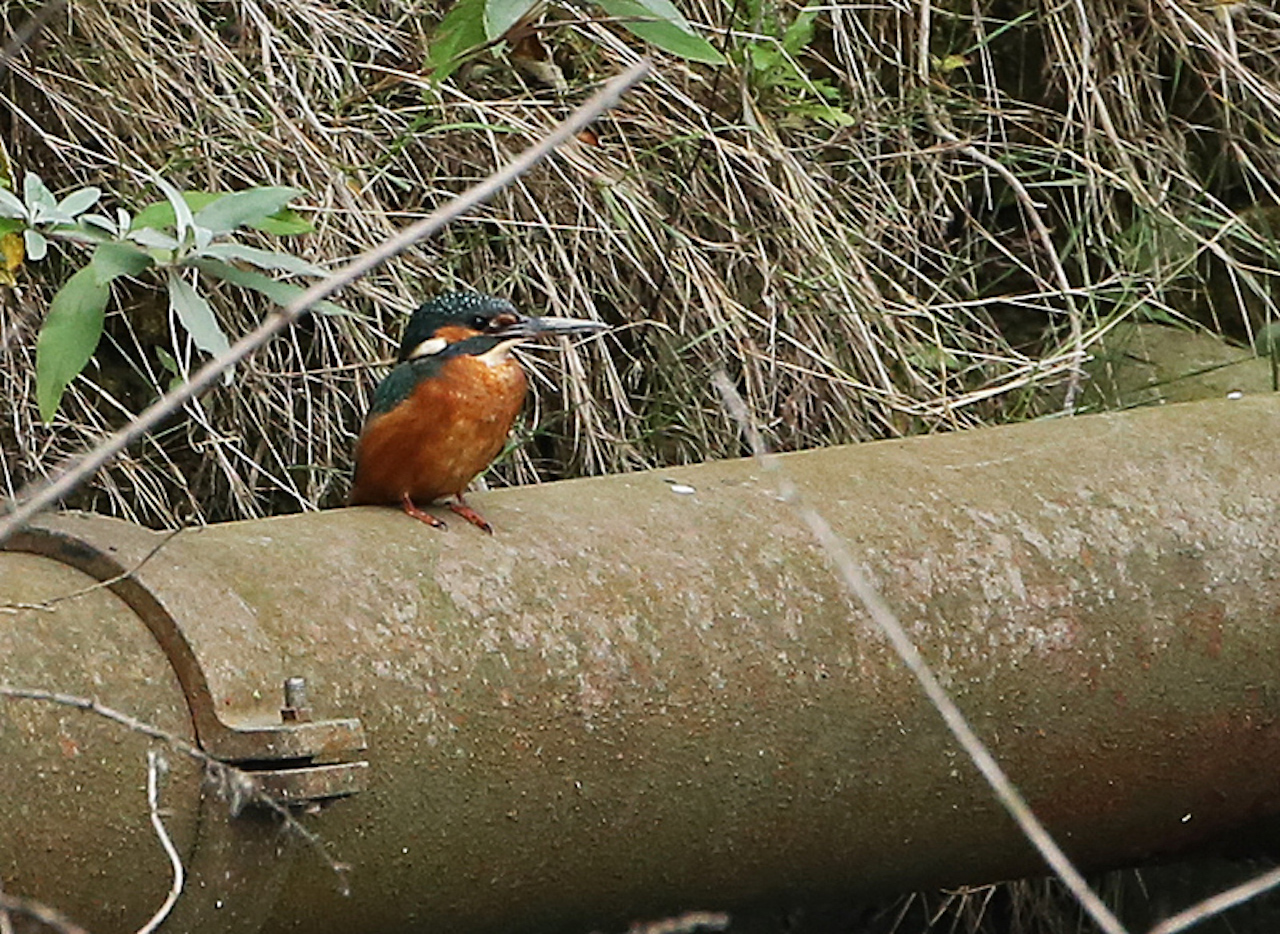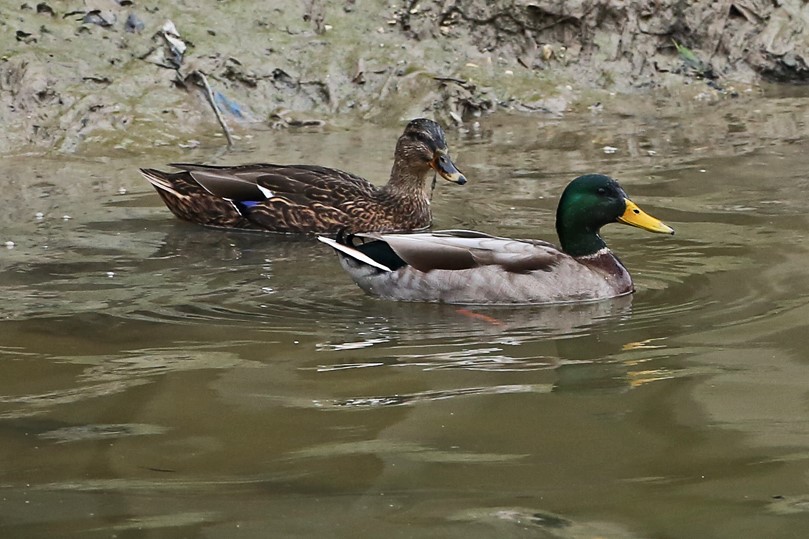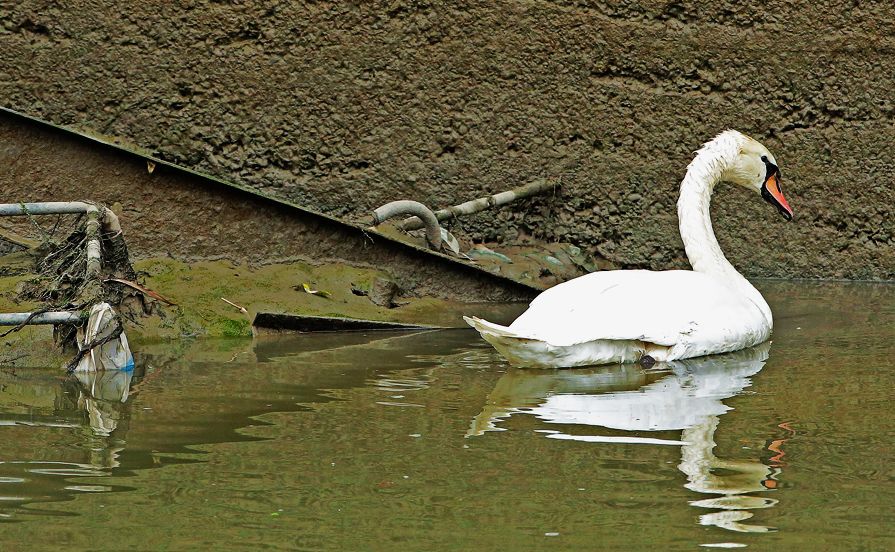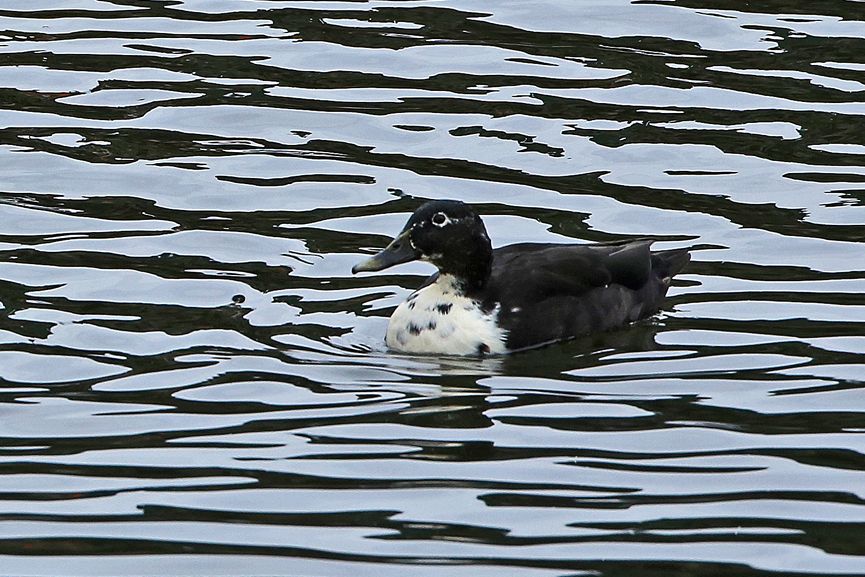By Paul Ferris
On what began as a fine, bright late January day, with the sun shining happily on Cody Dock and glistening on to the high-tide Lea, Cody Dock took part in the RSPB’s Big Garden Birdwatch event.
During the morning, mostly, the area was visited by 120 people, many of whom made notes of the bird species that they saw in and around the dock. We were by assisted by two members of the team that help out at RSPB’s Rainham Marsh Reserve, who set up an information table and provided telescopes and binoculars on our observation platform which gave a view not only across the premises but also onto and across the river.
“During the morning, mostly,” was quite apt, as by the time the afternoon had happened, clouds were rolling in as the tide was rolling out, a breeze which had not been too noticeable in the sunshine became chilly without it, visitors became less as the rain started pattering down, and eventually the observations closed down as the telescopes were packed away.
The Big Garden Birdwatch takes place each year, and has, since its inception, morphed slightly to encompass parks and other spaces as well as gardens. Although the advice is to spend just one hour logging the birds seen from your observation point, so as to make the event more publicly friendly, we logged for as long as there were people passing through and willing to take part.
Events such as this are helping us to build up a picture of what lives in and around Cody Dock, and what visits during the year. For most people, it is perhaps birds that first begin to arouse their interest in wildlife. Many people also have an interest in their gardens, or their allotments, and so plants and flowers – wild or cultivated – may be their main interest. Hence the profusion of books on “British Birds” or “Wild Flowers of Britain” that are so readily available these days. During the “quiet” days of that part of summer when the birds are less noticeable – out of the way raising young or out of sight amongst the leaves of trees – many birders (a technical term!) have taken to watching the aerial antics of other fliers, such as the dragonflies and damselflies.

Then their interest might extend to bees, wasps and beetles, then maybe spiders, then – well, almost anything that grabs someone’s attention. Those whose main interest may have been wild flowers, that is to say plants with flowers on, begin to realise there are a whole host of other growing organisms: mosses and liverworts maybe, and some that aren’t even really plants at all – fungi, for example.
So, what of Cody Dock? What lives here, what visits, what do we know? The Garden Birdwatch provided us with a few “new” bird species – that is to say species which we had not noted before, or at least hadn’t got written down. One of these, surprisingly, was Dunnock – otherwise known as the Hedge Sparrow, but more strictly a Hedge Accentor. A strange new one, this, because each time I’d visited Cody Dock I’d been aware of this pleasant little bird, easily mistaken by the casual observer for a House Sparrow, which is probably the reason for it being a “new one”. In all, 36 species of bird were recorded, plus another couple which we shall look at later!

Early in the creation of the Cody Dock Project, the extensive bed of reeds nearby on the banks of the River Lea held a Bittern. Though this hasn’t been seen (or heard!) subsequently, the fact that it regarded the reed bed as at least a temporary habitat is encouraging, and proves the value of such an environment. During the summer, these reeds – which are the Common Reed Phragmites Australis (as used for thatching) hold numbers of Reed Warblers. These are summer visitors, and their loud and chattering call is a distinctive feature which can be heard even from the riverside path immediately adjacent to Cody Dock itself. There is more reed even in the actual dock, and it is intended that this be enhanced – although will need to be controlled as well.
Birds making actual use of the river include a variety of duck species, typically Mallard, Tufted Duck, Gadwall and the small Teal. It was nice to see small flocks of Teal fly into the dock as the tide went out on the Birdwatch afternoon. However, many more had taken to lining up and resting along the boards that bolster the river walls on the Poplar bank. I counted about 30, although there were doubtless more that I was unable to see from my vantage point. From the small Teal duck to the considerably larger sheldduck, seven of which were counted during the day, and also the resident Egyptian Geese, of which a few are usually present somewhere between Bow Locks and Cody Dock. These Egyptian Geese are in fact actually classified as a duck, and probably most closely related to the sheldduck.
Originally – as the name implies – they were a species native to Africa south of the Sahara, but breeding flocks were introduced into places such as Holkham Hall in Norfolk in the 19th C., and – unpinioned – some escaped. It is now a common and widespread breeding bird particularly in the east of England, including the London area. The common true goose to be frequently seen in the Cody Dock area is the Canada Goose, another introduction which has proved all-too successful in Britain. As yet we have not had a record of the native Greylag goose, although this may change in the not-too distant future as numbers are certainly building up on Wanstead Flats – not too far distant as the goose flies. Mute Swans are also present on the Lea hereabouts, looking – as they do – somewhat resplendently stately in what – after all – is a somewhat industrial landscape.
Other water-side birds to be seen frequently are Cormorants – which make good use of the multitude of fishes in the Lea – as do Great Crested Grebes. No reports of Little Grebes yet, but distinctly possible, and they could even make use of the dock. There are wading birds, too, and the two most common are the Redshank and the Common Sandpiper, both of which make use of the mudbanks when the tide is low. As well as the common Heron, a more recent visitor is the brilliant white Little Egret, a relatively recent colonist to Britain originating more typically from Mediterranean regions.

I mentioned in the bird count 36 species, plus another two, and one of those I shall introduce now. Amongst the Mallard that can be seen feeding on the Lea, and in the dock, are a number of dark-looking ducks which have been put down on the list as “Cody Wild Ducks”. These are in fact Mallard, although some are very distinctly coloured. The Mallard (Anas platyrhynchos) is often known as the common duck, as it is widespread through the Americas, Eurasia, and North Africa, and as an introduction to many other parts of the world. It has formed the basis of numbers of domesticated varieties – some for food, some for ornament – and even other closely-related species of duck other than Anas platyrhynchos will interbreed.

These dark Cody Wild Ducks are probably the result of some back-crossing between a domesticated variety and the local wild mallards, although there is an American Black Duck which has been said to have been introduced and may be its provenance. It isn’t unusual to find any numbers of ducks raging in colour from pure white to black, and including some rather strange physical forms as well. These Cody Wild ducks look like they may be on their way to developing a strain of their own – but they’ll doubtless not be too particular about mixing with the wild ones!
And of course, commonly around the river are a variety of gull species. Though once commonly referred to as “seagulls”, they really can’t be designated as belonging to the sea any more, as some species – particularly Black-headed and Common gulls – are just as happy inland. But here at Cody Dock the influence of the sea is strong anyway; the history of Poplar and Canning Town is closely associated with a strong maritime history. Cody Dock itself is evidence of this. So gulls would for long have used the River Lea to forage, as they do in profusion nowadays, but even on the rooftops of the neighbouring business park, hundreds of gulls will readily be seen and heard. Apart from the widespread Black-headed and Common Gulls, Lesser Black-backs and Herring Gulls use the riverside and feed hungrily on the Flounders that find their way up the Lea from the Thames.
A couple of other bird species associated with water may be expected to be observed around Cody Dock. One of these is the brightly yellow-coloured Grey Wagtail (they are actually yellow and grey, but the yellow is outstanding and the name serves to distinguish from the all-yellow Yellow Wagtail, which we haven’t seen here). The other wagtail which is common here is the Pied Wagtail, not necessarily seen by water but often associated with it. And – everybody’s favourite – and often seen as a flash of blue flying into the dock or along the river, the Kingfisher. This has been seen frequently enough to suggest that it might be breeding locally, maybe even in the Cody Reed Bed.

There are a number of bird-feeders put up in the public part of Cody Dock, and these attract a range of common garden bird-species: Chaffinch, Greenfinch, a number of Tit species, Wren, Robin, Blackbird and – as mentioned – Dunnock, amongst others. There are pigeons, of course – Wood Pigeons do occur and certainly the town or Feral Pigeon. These latter, it may not be realised, originated from the domestication through the ages of wild Rock Doves – natural denizens of wild rocky cliffs. Escapes from domesticated stock for centuries, and the birds finding that town buildings happily reproduced their natural habitats, the profusion, habits and size of these birds have given opportunity to one of our most dramatic birds to feast. This is the Peregrine Falcon, and this bird has been seen locally, and not infrequently, seeming to favour the gas-holder structures on the Poplar bank. Two others to mention: a Pheasant was seen walking through the area, and the second of those additional birds that I mentioned earlier – what about the domestic chickens that are kept at the dock?!

Enough of birds; what of other creatures? The most obvious, although not necessarily frequently seen by the casual visitor, would be mammals. These include Foxes, Squirrels, Rats, and bats. The latter may be seen flying over the dock, but species are not easy to determine by sight alone. However, use of bat-detecting equipment by a bat-group determined that four species were present: Pipistrelle, Long-eared, Daubenton’s and Noctule. It may be that there are at least five, as the actual species of Pipistrelle noted here hasn’t – to my knowledge – been determined. There are actually three similar species of pipistrelle, at least two of which may well be present. Harbour Seal (also known as the Common Seal) and Harbour Porpoise have been observed in the Lea nearby, and with the Thames increasingly favoured by these animals and the Lea becoming increasingly clean, the numbers of these large mammals seen around Cody Dock may well increase.
A survey of the invertebrates has taken place in the nearby reed-bed, so a start has been made on finding out something about other life-forms, such as insects. Some of these will prove to be quite evident – the butterflies, dragonflies and damselflies which frequent the area, for example, and the possibility of putting out a moth trap to get an idea – without harming the creatures – of moth species that occur. There is so much that needs to be observed.

The area that it is hoped will be looked at to ascertain its wildlife population is the dock area itself, the approach roads from Star Lane Station – which require a lot of care and attention – and the Leaway from Bow Lock. At present this is over-manicured, with a variety of what could be valuable habitat planted shrubs being cut back severely, and grass verges being mowed inappropriately. This is the stretch which has been optimistically renamed “Cody Wilds” through a collaborative project with Cody Dock’s own charity GDP, Kew Garden’s Grow Wild project and the river clean-up charity Thames21. The RSPB have also lent their weight to a call for a relaxed maintenance program that would support the diversity of the habitat and enable the existing wildlife to flourish. The long-term aspiration is for this stretch of path to become a community managed linear park connecting the existing Bow ecology Park to the south and Three Mills to the North. Up near to Twelvetrees Crescent bridge is some quite thick woodland in the memorial park there, and the area surrounding the gas holders may prove a valuable habitat as it has been relatively undisturbed for so long.
We have so much here: tidal river and canal, mud flats and reed beds – as well as the industrial landscape itself. Apart from mention of the reeds, we haven’t even touched on the plants in this article. We have hedgerows planted with native species, we have urban wilderness, woodland, ornamental gardens and lawn. We have a lot to discover.